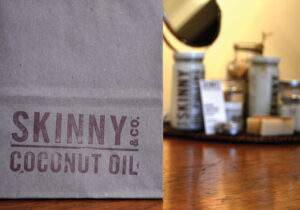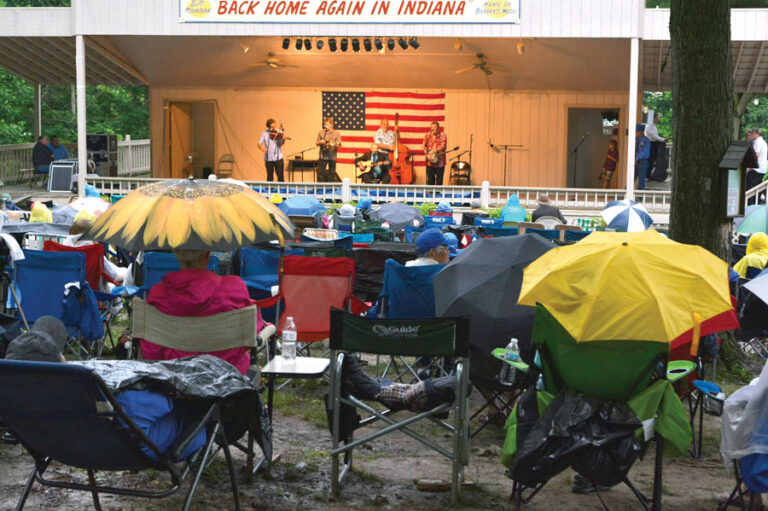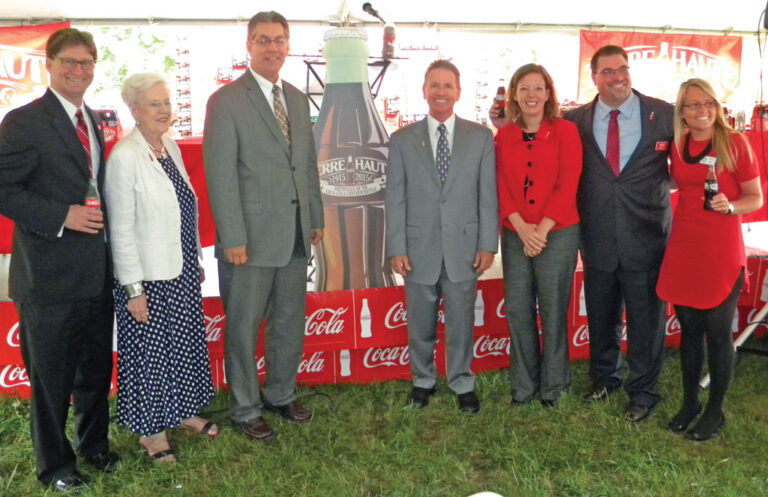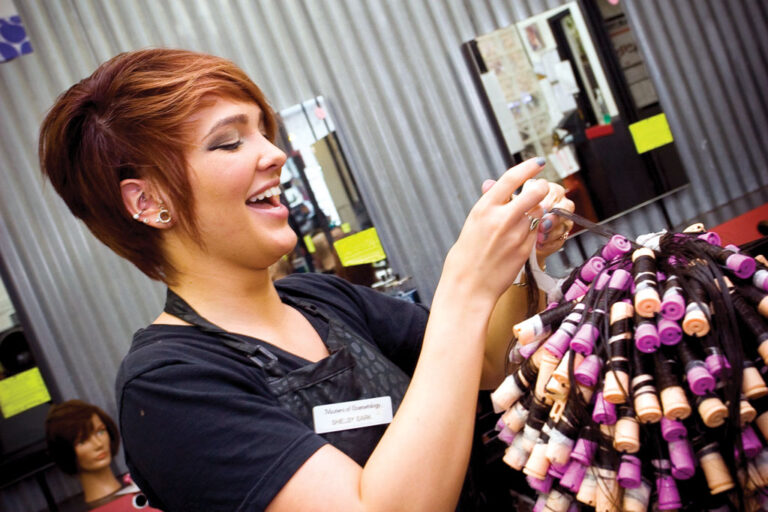Bill Monroe’s Bean Blossom Bluegrass Festival, the world’s oldest continuous running bluegrass festival, returned to Brown County for its 49th year. For eight consecutive days, more than 70 bands took the stage showcasing some of the best in bluegrass. The family-friendly event also included daily music and instrument workshops. Nestled in the beautiful hills of Brown County is the Bill Monroe Music Park & Campground, proud host of the festival. Dedicated to the memory of Bill Monroe, trailblazer and music legend, this unique venue has become known as the “Mecca of Bluegrass.”
U.S. Fleet Forces Band comes to Indianapolis
The U.S. Fleet Forces Band and all of its music ensembles performed numerous concerts around Indianapolis in support of Indianapolis Navy Week. Established in 1945, the U.S. Fleet Forces Band serves as the Navy’s musical ambassador for the Hampton Roads and the Mid-Atlantic regions. The band performs more than 600 engagements annually. Its mission is to provide musical support for the U.S. Navy afloat and ashore, support Navy Recruiting, inspire patriotism, elevate esprit de corps and pride in the Naval Service and enhance community awareness and public relations events at home and abroad. The “Finest in the Fleet” plays for audiences totaling in the millions every year.
Coca-Cola brings celebration of contour bottle to Terre Haute
As Coca-Cola commemorates the 100th year of the contour bottle, the company stopped by Vigo County Historical Museum in Terre Haute to thank everyone who has helped make the milestone possible — especially Hoosiers who created the contour bottle in 1915. Today, The Coca-Cola Company is the world’s largest beverage company, refreshing consumers with more than 500 sparkling and still brands. The company’s portfolio features 20 billion-dollar brands including Diet Coke, Fanta, Sprite, Coca-Cola Zero, vitaminwater, POWERADE, Minute Maid, Simply, Georgia, Dasani, FUZE TEA and Del Valle.
Indianapolis Greek Festival features food, dancing
The Greek dancers perform a Grecian dance called the Zorba during GreekFest 2015. This year marked the 42nd year for what has become one of central Indiana’s oldest and largest ethnic festivals. Hosted by the Holy Trinity Greek Orthodox Church in Carmel, the GreekFest is known for its array of authentic Greek cuisine, fine wines and fresh pastries, many of which are only available once a year at GreekFest.
Mother of ‘King of Pop’ visits Gary
Katherine Jackson, mother of the late, Michael Jackson, presented the sixth annual “I Can’t Stop Loving You Charity Weekend.” The two-day, event was free and provided family entertainment, such as rapper Wale (pictured here), and the distribution of backpacks, school supplies and giveaways to thousands of children. Katherine and the children of Michael Jackson are committed to providing the children of Gary with the essentials for the new school year. They understand the importance of having access to resources, particularly for those living without the proper finances. By presenting this annual event, the Jackson family hopes to put smiles on the faces of local children and families.
Pierogi Fest shows regional civility commitment
 The Whiting-Robertsdale Chamber of Commerce, the Gary Chamber of Commerce and The Times of Northwest Indiana demonstrated the region’s continuing commitment to the “Community Civility Counts” campaign at this year’s Pierogi Fest in downtown Whiting. The July festival drew national and international attention and for the 10th consecutive year was named best festival by readers of The Times. Organizers of Pierogi Fest invited elected officials, local business leaders and residents to demonstrate the region’s civility by volunteering to serve as greeters to the more than 250,000 attendees of the festival.
The Whiting-Robertsdale Chamber of Commerce, the Gary Chamber of Commerce and The Times of Northwest Indiana demonstrated the region’s continuing commitment to the “Community Civility Counts” campaign at this year’s Pierogi Fest in downtown Whiting. The July festival drew national and international attention and for the 10th consecutive year was named best festival by readers of The Times. Organizers of Pierogi Fest invited elected officials, local business leaders and residents to demonstrate the region’s civility by volunteering to serve as greeters to the more than 250,000 attendees of the festival.
Entrepreneurs, health care leaders find cures for what ails Indiana’s health and beauty industry
By Victoria T. Davis
Three point two trillion. That is the amount Americans are expected to spend on health care this year, according to the Centers for Medicare and Medicaid services.
If accurate, the projected total will make 2015 the first year health care spending will reach $10,000 per person. Health care is in high demand, but the good news is, it’s readily available through state programs such as the Healthy Indiana Plan 2.0 and national programs such as the Affordable Care Act.
Americans aren’t spending their health-related dollars only on traditional health care — the ever-expanding and evolving beauty and cosmetic industries also rank priority for Americans. Mint.com, a finance website and mobile application used for tracking spending, found the average woman spends about $15,000 during her lifetime on beauty products. This total does not include money dedicated to beauty practices and alterations, such as plastic surgery and other body modifications.
Indeed, these figures include Hoosiers who are continuously focusing on their inner and outer health while demanding services catering to their every need. Due to the state of Indiana’s wellness, climbing hypertension and obesity rates, health and beauty businesses are putting an emphasis on local, reliable services such as insurance and holistic health.

Dr. Antoine Leflore, emergency medicine physician at Eskenazi Health, one of Indiana’s county hospitals located just west of downtown Indianapolis, said the emergency room sees about 100,000 patients each year, with about 45 percent being minorities.
“One of the major reasons patients show up to the emergency department is because they don’t have health insurance. Other reasons are because we’re open 24/7 and you don’t need an appointment,” says Leflore.
Local companies — such as MDwise, a nonprofit health maintenance organization focused on helping uninsured Hoosiers in need of health insurance, and Ambre Blends, an independent woman-owned business aiming to provide high-quality, organic body products to help individuals live a more holistic and healthy lifestyle — are changing the landscape of the health and beauty industries in Indiana.
Discover the passion within
Cesar Martinez, new president and CEO of MDwise, has not only worked his way to the top of a respectable company, but he is also knowledgeable about what it takes to build a local health insurance business from the ground up. In 2010, he founded and launched Palmetto Physician Connections (PPC), a Greenville, South Carolina-based Medicaid plan. In less than two years, the business grew to 24,000 members.
In 2012, Martinez created Advicare, a new health plan for the area’s local hospital system. Martinez believes if one is interested in jumping into the health care industry as an entrepreneur, they should note there is more to the business than finances. “You have to have a passion for it, or you’re going to fail. If you don’t (have passion) it will be challenging, because there are so many hurdles you must overcome when you’re starting a new company.
Especially in health care, there are so many big businesses to compete against and many changes and regulations,” says Martinez. “Obviously you need financial support, but money is only going to get you so far.” The motivation behind PPC, Martinez’s first health care venture, came from the lack of local health care companies providing services and jobs. Several giant corporations were available, but nothing to cater to the local community. Martinez seized the opportunity to hire locally and keep cash flowing within the state and city. In addition to meeting the community’s need, Martinez said the venture was both a professional and personal goal of his. “A lot of people thought I was crazy because it’s so hard to start a company, especially in health care, and especially in insurance, because there are so many regulations and steps you have to go through,” he says. “To create an insurance company, it takes months and sometimes years before you see one penny come in. You have to convince and prove to the government that you can sustain yourself. Having a nice idea isn’t all of it.”

In June 2014, two Indianapolis downtown hospitals operated by Indiana University Health announced plans to merge University Hospital and Methodist Hospital. Martinez said similar situations aren’t uncommon due to the difficulty of sustaining smaller companies. Despite the apprehension Martinez experienced, he enrolled thousands of members in a short time period. He believes a couple of the reasons his company thrived is due to working at the grassroots level and developing close, tight-knit relationships. Getting primary care providers, churches and schools on board and convincing them to believe in the health care provider’s mission and goals was key.
“You can’t do that from a phone on Wall Street like big businesses do, you have to do it face to face,” Martinez said. “That grassroots relationship was a big part of our success, because people saw that not only were we talking the talk, but we were walking it, and it developed a snowball effect.” Launching and operating a successful health care company isn’t the only thing Martinez has under his belt — he also is familiar with what it takes to sell a health care company when it’s time to move on. PPC had a handful of individuals interested in pursuing and progressing the business, and Martinez received more than one offer.
The idea was to sell the company to a local hospital to keep the same mission and vision developed from the very beginning. “I could’ve sold to a large company and sold out, but that wasn’t what was going to be best for the business. I had to stay true to my word,” says Martinez, who believes those interested in selling their company should take time to connect with the correct buyer, whose mission and vision align with the company. Both Leflore from Eskenazi Health and Martinez agree that Indiana’s current state of health affects the implementation of new health programs and the action of closing disparities. “When we talk about minority health, I get a chance to see a significant health disparity,” Leflore said. “Around the country there are specific health disparities such as hypertension, diabetes, infant mortality, HIV and the list goes on. With that, I’m able to see the full spectrum of our patient population. It is a reflection of the needs in our community and the lack of access to health care.”
In order to accomplish those tasks, leaders must have a fire ignited within them and want to make a change in their community, said Martinez. “There were so many days and nights where I wondered where the money was going to come from,” Martinez said. “But it starts with what is in the heart. The old quote from Aristotle says, ‘If you don’t educate the heart, you cant educate the mind.’”
There’s no quick fix
Since 2001, Ambre Blends, created by Ambre Ashley-Crockett, has produced high-quality and organic body products for Hoosiers and has recently expanded to reach those around the U.S. and globally. The company, well known for its four fragrances infused with Amber oil, believes beauty not only comes from outer appearance, but also through the products absorbed through the body’s largest organ — the skin. “It is our state that got Ambre Blends off the ground, so I believe beauty is definitely important for people here,” says Ashley-Crockett, who says she launched her beauty company in “reverse order.” “There is a desire for clean, conscious products,” she said. “Once people get into it they discover, oh there’s a natural deodorant and cleaning supplies. It (sparks) an interest for people to look at more than body products.”

At the age of 21, the Indianapolis native moved to Colorado hoping to discover her place in the world. After pondering more seriously about what she wanted to do, she found interest in massage and aromatherapy as a hobby. Ashley-Crockett enrolled in school at the Healing Arts Institute in Fort Collins, Colorado, and began working for an herbalist who developed all-natural products for women. “I learned a lot about herbs and how they work, not just for the skin and body but on an aroma level. I started making my own concoctions, and I cared for a garden where I grew my own herbs,” says Ashley-Crockett. “I was learning how to make oil, things that go in the body and on the body.”
In 2001, Ashley-Crockett moved back to Indianapolis and took her bathroom-made concoctions a step further. She began making body products for fun, even using handwritten labels, and eventually moved into the kitchen once her blends became more of a priority. The ground-breaking moment for the business happened once a local boutique, now called Haus Love, requested to sell the products. “At the time I thought, ‘I don’t think they know I hand write the labels and I make this from my home,’” Ashley-Crockett said with a giggle. Shortly after, the kitchen concoctions were sold on the shelves. “When I started in Indianapolis, the holistic health and medicine era was just picking up, so I really was in the right place at the right time.
Back in Colorado, it was everywhere. I like to think I was on the forefront of introducing a conscious product line that provides a lifestyle change,” Ashley-Crockett said. “My definition of beauty has nothing to do with my products. It truly does come from within, and I think that’s beautiful. When I see someone who is confident and loves who they are through self-care, it’s just the cherry on top when they use good products to enhance that.” Ambre Blends’ unisex products include fragrances, natural deodorants, body oils, handmade soaps, body wash, spritzers and more.
Each oil product works with an individual’s personal body chemistry to create a unique scent. Amber oil, the oil found in all four of the brand’s blends — Ambre, Invoke, Solace and Unmasque — is also known for its aphrodisiac properties. In today’s society, the popularity of “extreme” beauty practices such as Botox and rhinoplasty not only run risk of infection, but also can send individuals to the emergency room. Experts believe everyday beauty products with toxic chemicals can also have long-lasting negative impacts on the body that could later deteriorate one’s health. The average woman is said to apply about 515 different synthetic chemicals on her body every single day, according to research by Bionsen, a natural deodorant company. “I feel like people want a quick fix, but (cosmetic surgery) just looks so unnatural.
It takes away that beauty I mentioned, and it’s almost like a Muppet. Seeing someone’s facial expressions, their natural eye color, their crows feet, I love these!” Ashley-Crockett said, pointing to her eyes and smiling. “They can get that on a holistic level if they just knew how and had some patience.” Judging by the sales of Ambre Blends products, which are all packaged in biodegradable or recyclable packaging, the demand of natural and organic products is on the rise. Ashley-Crockett says the company is growing at 35 percent annually.
About 50 percent of business is through the company’s online sales, and the other half comes from in-store purchases. The blends have gained so much popularity, they have been previously mentioned in Allure magazine. Last year, the company purchased its first building in Indianapolis, equipped with its own disco ball. When it comes to developing a business plan, Ambre Blends still doesn’t have one after 14 years in operation. “I’ve always had it in my mind that our plan was for the business to figure it out and for it to happen organically. It’s so funny, people ask me if I’m a chemist and I tell them I’ve failed geometry and never took a chemistry class,” said the mom of two. “I was already doing something, and it took off and shaped a life of its own. Not getting a loan, not writing a business plan, growing grassroots and only taking on another thing when you’re busting out at the seams of the last thing, that is the way we did it. We have never had to borrow a dollar.”
For those looking to venture into the beauty industry, Ashley-Crockett says there is room for everyone, but it all links back to integrity. “Believe in what you’re doing. It has to be something you’re passionate about, because if you’re just in it for the money, it won’t work,” she said. “The reason we’ve done so well is because of the love and the integrity that goes into it.”
hoosiers cold-press raw coconut oil from Vietnam jungles
By Victoria T. Davis
Photos by Mikala Lomax
Whiten your teeth, lighten age spots, moisturize your skin, condition your hair, strengthen your immune system, reduce gum bleeding and inflammation — the list of ways to use cold-pressed coconut oil goes on.
 Skinny & Co., with its roots in a small Indianapolis neighborhood called Broad Ripple, claims to sell the only 100 percent raw, alkaline coconut oil in the world. Using the “Nutralock” system, an exclusive extraction process that uses a cooling process (rather than heat) to release coconut oil, Skinny & Co. harvests its coconut oil directly from the jungles of Vietnam. The oil contains no chemicals, solvents or fillers.
Skinny & Co., with its roots in a small Indianapolis neighborhood called Broad Ripple, claims to sell the only 100 percent raw, alkaline coconut oil in the world. Using the “Nutralock” system, an exclusive extraction process that uses a cooling process (rather than heat) to release coconut oil, Skinny & Co. harvests its coconut oil directly from the jungles of Vietnam. The oil contains no chemicals, solvents or fillers.
The Indiana Minority Business Magazine (IMBM) sat down with Matt Geddie, president of Skinny & Co., to learn more about the increase in popularity of the brand and what day-to-day business operations are like.
IMBM: I know you and your brother Luke created the idea of Skinny & Co. while traveling in Vietnam, but what was the process like?
Geddie: We grew up very health-minded, and as a child I suffered from a terminal illness, and it was fresh fruits and vegetables that turned my health around. My mother (Joy Reese), our vice president, is a holistic doctor. While my brother Luke and I were traveling to Vietnam, we met our business partner Kim Vo. We all started talking about creating an import/export business and began sourcing raw ingredients, and during that process we found the consumer was only receiving 1/100th of the nutritional value because of the food manufacturing system. It’s hard to make food that’s healthful inexpensive. We knew there was a better way to manufacture food to retain value. We started with coconut oil, because there are a million and one uses for it. We do a lot of education with that as well.
From that point, how did the Nutralock system, your patent-pending technology, develop?
Luke, who lives in Vietnam full-time now, met a Vietnam refugee who built the technology to make coconut oil. When we met him, he was still trying to figure things out and hadn’t refined it yet. Phase two was finding the highest quality increments possible and bringing them directly into our market to cut costs for the consumer. Skinny and the technology we use kind of fell into our lap after we all sat down and partnered. We launched Skinny two years ago in September.
The name Skinny & Co. is very ironic considering your line of products. How did the name emerge?
My mother and brother came up with the name by asking, “What does it do for you?” They said it makes you healthy and fit. The Skinny jar stands out (amongst other brands). It’s an oxymoron since coconut oil is a fat, it’s skinny fat and if you’re walking down an aisle, it’s attention grabbing. Although people may pick it up thinking it may help them lose weight, it’s going to give you more of the halo effects of the oil.
I understand the company recently celebrated its two-year anniversary, congratulations! I also know your brand continues to grow in popularity each day, especially with celebrities such as Kristin Bauer from “True Blood” and Sergio Brown, formerly of the Indianapolis Colts. What are sales like?
 We’ve grown 100 percent every year, so it’s been crazy. This year we should do about $800,000 in sales, and we’re growing pretty quickly. We’re now trying to grow more strategically. Get out into the Midwest and really build the brand of Skinny here.
We’ve grown 100 percent every year, so it’s been crazy. This year we should do about $800,000 in sales, and we’re growing pretty quickly. We’re now trying to grow more strategically. Get out into the Midwest and really build the brand of Skinny here.
As you are in high demand, what are some of the biggest challenges the company has faced?
One of our biggest issues is logistics. We’ve had to become logistics experts pretty quickly, because from a cash flow and order management standpoint, from the day we’re making the coconut oil to the day it arrives is about 60 to 75 days. That’s managing cash flow, because when we (pay) out $20,000, $30,000, $40,000, and we aren’t going to receive the product until about 60 days later, and that product won’t be sold for the next 60 days… (We’re) leaving $180,000 receivable, which is nuts. That’s an issue we’ve been trying to figure out.
What are the day-to-day operations like for your Broad Ripple headquarters?
Although we’re sold in seven different countries, in-house is where we handle customer service, process order management, new product developments, and we ship out direct and online orders. The oil that ships in bulk comes from a certified facility here in Indiana. Most of everything we do is in Indiana. Vietnam is where they harvest the coconut oil.
You offer a beauty and oral health line of products. Are any other items in the works? Every product we sell we want to keep under five ingredients. When we create a new product our biggest thing is, is it edible? Because your skin is your largest organ. And can you pronounce everything it’s made of? Our beauty line includes a facial oil, body butter, lip balm and shampoo bar. We’re going to launch vanilla body scrub soon, along with 10 other beauty products that are in the works.
For more information on Skinny & Co., visit Skinnyandcompany.com.
Cosmetology, esthetics virtually ‘recession-proof’
By Lauren Caggiano
The future is bright for those pursuing an education in the beauty/wellness industry. Kaydean Blackman Geist, co-owner of Masters of Cosmetology in Fort Wayne, Indiana said many career paths exist for students wanting to make people look and feel great. Masters of Cosmetology is committed to providing an education to both female and male students in the art and science of beauty.
That includes everything from hair, to skin and body massage. In regards to hair, color correction is always in demand, Geist said. But some students want to do more than just scratch the surface — literally. Instead, they might seek employment at a medical spa or similar facility. “We see a lot of (students) wanting to work in the medical field, alongside doctors,” Geist said. Others wish to take a more entrepreneurial approach, going into freelance makeup or hair design.
Geist specifically cited a trend in special effects/theater makeup. For example, graduates can create scars and other scary elements for theatrical productions or Halloween events. Another common theme Geist sees is the need to be a well-rounded graduate. A lot of students have prior education when they come to Masters, and it’s common for students to take business classes during or after their beauty school education.
“So many students don’t want to just be a hairdresser, but want to run their own business,” Geist said. Regardless of the career path, Geist says business classes can provide a solid foundation, so you can learn instead of making amateur mistakes on the job, and a cosmetology or esthetics background can come in handy, even if it’s not the chosen career path. That’s because it’s virtually a recession-proof field. Geist said Baby Boomers tend to be focused on health and beauty, so there’s a market for catering to their needs. And the statistics back Geist’s anecdotal comments.
Although growth rates vary by specialty, the Bureau of Labor Statistics (BLS) projects that employment in this sector will grow by 12.7 percent. Demand to receive extensions, hair color, straightening and more could translate to 77,600 new cosmetologist positions by 2022. There are also the benefits of unlimited earning potential and freedom. Hairdressers and estheticians aren’t typically salaried employees; most are self-employed and many work part time. The BLS reports the median hourly wage for hairdressers in 2013 was $11.12, which translates to $23,140 a year. The best-paid earned approximately $44,220, while the worst-paid made about $17,010.
Brittany Schnare, who will graduate in November from Masters, is one who will enter the workforce shortly. She plans to pursue a career in a salon or become a freelance wedding cosmetologist. The 25-year-old said she has long known cosmetology was her calling. “I’ve always loved makeup and hair… making people beautiful,” she said. Masters of Cosmetology is one of several options in Indiana for those seeking training in the art and science of beauty.
There are many reputable institutions across the state. Here are a few, by region:
Northeast Indiana Ravenscroft Beauty College
4530 Lahmeyer Road
Fort Wayne, Indiana 46835
(260) 486-8868
Rudae’s School of Beauty Culture
5317 Coldwater Road
Fort Wayne, Indiana 46825
(260) 483-2466
Central Indiana Empire Beauty School
3810 E. Southport Road Indianapolis, Indiana 46237
(317) 489-5656
Regency Beauty Institute
5939 E. 82nd St. Indianapolis, Indiana 46250
(800) 787-6456
Northwest Indiana Don Roberts School of Hair Design
152 E. US Route 30
Schererville, Indiana 46375
(219) 864-1600
Merrillville Beauty College
48 W. 67th Place
Merrillville, Indiana 46410
(219) 769-2232
Southern Indiana The Salon Professional Academy
5545 Vogel Road
Evansville, Indiana 47715
(812) 437-8772
Roger’s Hair Academy
105 N. Green River Road
Evansville, Indiana 47715
(812) 402-1100
Sex therapist answers Hoosiers’ most embarrassing sex questions
By Victoria T. Davis
When talking about health care, disease and nutrition are frequently and freely discussed. Sexual health is not discussed as often, although it plays a vital role in an individual’s well-being. A study by the Alan Guttmacher Institute titled, Sexual and Reproductive Health: Women and Men, found at least three-fourths of all men and women had intercourse by their late teenage years, and more than two-thirds of all sexually experienced teens have had two or more partners. As the study shows, Americans are very familiar with sex, but are they educated on the subject?

Indiana Minority Business Magazine spoke with certified sex therapist and licensed mental health counselor Lara West, of Mount Saint Francis, Indiana, to get answers to some of Hoosiers’ most daring and embarrassing sex questions.
IMBM: Is it normal to lose interest in the middle of sex?
West: There are several reasons why one might lose interest in the middle of sex. Low testosterone can be a reason. Maybe your partner is not an attentive or competent lover. Maybe something else is on your mind or you are not in the mood. One thing you can do if you find your mind wandering during sex is to check in with yourself and your partner. Are you being an active participant? Discover what you can do to bring yourself back into the moment and make things more interesting.
Why do some people have a hard time achieving an orgasm?
There are multiple reasons for experiencing difficulty in orgasming. Medications, alcohol, anxiety and trauma are all factors that could prevent an orgasm. Check with your doctor to see if your reproductive area is working OK, if your hormone levels are within normal limits and to see if your medications have sexual side effects. If all of these check out OK, look at your alcohol use or other substance use before you have sex. Is anxiety or trauma affecting you sexually? And last but definitely not least, do you and your partner know your body well enough to know what stimulation you need to reach orgasm?
Is the G-spot real?
Yes, the G-spot is real. The G-spot (named after Ernst Grafenberg) is a spongy area on the belly-button side inside the vagina above the pubic bone. Some lucky women can orgasm when this area is stimulated, but not all women. Most women happily reach orgasm with clitoral stimulation; so don’t knock yourselves out trying to produce an orgasm by hunting down this elusive area, unless that is what makes you happy.
Some individuals find themselves ejaculating too quickly. What could be the problem?
Some men are biologically geared to rapid ejaculation. What I tend to see more often is less genetic and more anxiety-related. So for the moment, let’s not call it a problem, how about we just call it a pattern of behavior? Most patterns of behavior have evolved out of necessity, and so has rapid ejaculation. Maybe you learned this pattern so someone wouldn’t catch you masturbating, or you didn’t want the kids walking in on your date night, or your previous partner complained you take too long. So take this moment to retrain yourself. If Tiger Woods can refashion his golf swing, so can you.
Why can’t men have multiple orgasms like women?
I am happy to report that men can have multiple orgasms. After checking with my men’s sexuality gurus (thank you Jody and Jean), it appears that some men can have sequential orgasms, and it is more common when men can delay ejaculation. It helps to keep the sexual intensity at a high level as well.
Women are associated with faking orgasms. Are men just as guilty?
Heck yeah, men can fake orgasms too! Think about the man whose female partner wants to have a baby, but he does not, so he fakes an orgasm to make his partner believe he is doing his part. If everyone were honest and upfront about his or her sexual behavior with his or her partner, I would be out of a job! Seriously though, if someone is faking anything in a relationship, it may be a good idea to think about what is really going on. Why is there faking going on? Try to have an open conversation with your partner, and if this is not possible, seek out a therapist who can help clarify what the faking is about, what role it serves, and how to address it in the relationship.











